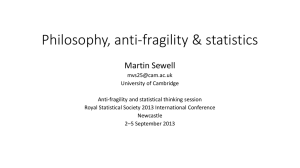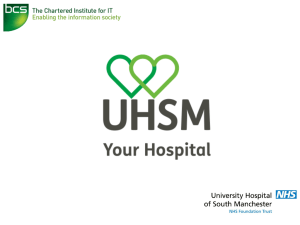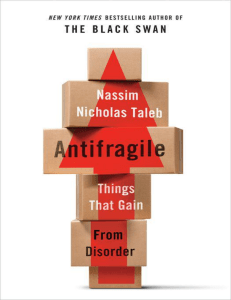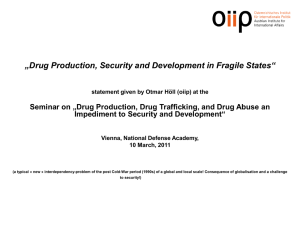here - WordPress.com
advertisement
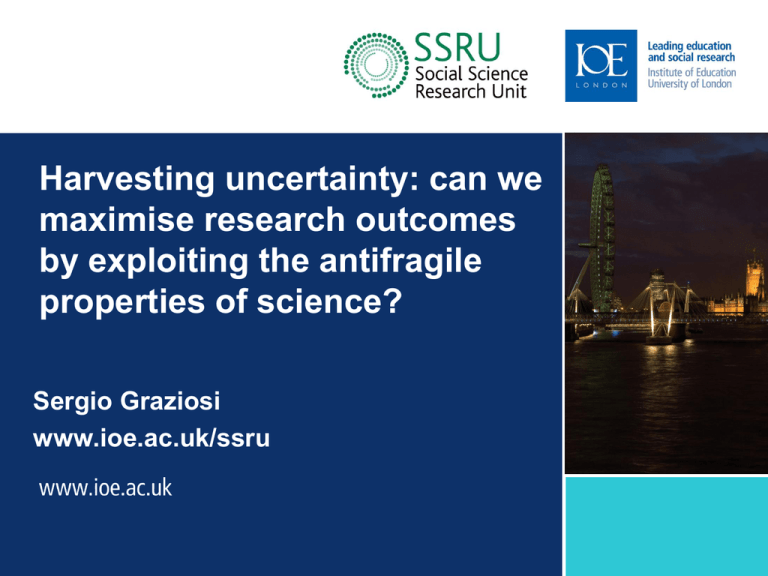
Sub-brand to go here Harvesting uncertainty: can we maximise research outcomes by exploiting the antifragile properties of science? Sergio Graziosi www.ioe.ac.uk/ssru This is a Seminar / Workshop Part one: Brief explanations of the concepts. Antifragility applied to Research and Social Science Part two: Practical tinkering using the antifragility concept. 2 Antifragility? What is this about? Serendipity Does science rely on serendipity? Yes and No Science relies on the convexity of its payoff function. Also known as Antifagility. Photo © CLCase from http://smccd.edu/accounts/case/antibiotics.html 3 Nassim Nicholas Taleb •The Black Swan: The Impact of the Highly Improbable •Antifragile: Things That Gain from Disorder Understanding is a poor substitute for convexity (antifragility) http://www.edge.org/conversation/understanding-is-a-poor-substitute-for-convexity-antifragility The antifragile is the exact opposite of the fragile which can be defined as hating disorder. A coffee cup is fragile because it wants tranquillity and a low volatility environment, the antifragile wants the opposite: high volatility increases its welfare. 4 Antifragility? Does it even exist? Domain FRAGILE ROBUST ANTIFRAGILE Transport Racing car Tank, 4x4 Horse Transport in London Train Bus Bicycle Market (profit) Stock exchange Supermarket Souk Knowledge Science book Journal Wiki Work Employee Employer Freelance Reputation Head Teacher Civil servant Commentator 5 Optionality makes science antifragile Discard Keep! Linear payoff function Convex payoff function 6 Knowledge-based research under high uncertainty Convex trial and error (antifragile) Pure knowledge (no convex tinkering) Nonconvex trial and error (pure chance) 7 Pure Chance Convex Research 8 Pure Knowledge Seven rules of antifragility in research 1. Convexity is easier to attain than knowledge. You can lower the cost of unsuccessful trials. 2. Convex strategies can be exploited by multiplying attempts. If failures are cheap, the more things you try, the better: you might get the JackPot. 3. Optionality is good. A rigid, long-lasting protocol reduces your options, (too much) planning under uncertainty reduces convexity. 4. Single humans are good at harvesting opportunities. Even a solid research project can be a restrictive plan. A solid researcher will change plans to follow opportunities. 5. Theory is born from (convex) practice more often than the reverse. Big discoveries are frequently the result of tinkering and luck (serendipity), theory then follows and explains. 6. Premium for simplicity (less-is-more). A complex explanation does not in itself add value, but may be rewarded as ‘good research’ independently from its usefulness. 7. Optionality depends of knowledge of negative and neutral results. The via negativa is effective, all failed attempts should be known and documented. 9 Is this it? You knew it already, right? Sure you did, but are we sure we grasp all consequences? Central Economic planning (-) Vs. Personal initiative (+) Vs. Big Corporations (--) Is it worth transforming our vision of policy making? Should we see the aim of policy making as: strive to generate antifragile systems? Can we make our research less fragile? Minimal take home message: the less you know, the bigger the advantage provided by additional options. Or: the more you know, the less harm is done by a rigid and long lasting research roadmap. Any questions? 10 1. Can you imagine how to promote antifragile research with funders and policy makers? How about antifragile interventions? 2. Results dissemination: does antifragility dictate it as an ethical requirement? Does it harm the original author as much as it benefits the community (or vice-versa)? 3. Can you make an argument in favour of immigration based on the antifragile concept? Will anybody buy it? 4. Imagine you have won three research grants: one is big, will require 2 years of full time work for the whole team (option A). The other two can be carried on simultaneously and will both finish in 2 years (option B). Both options seem equally good. Does antifragility give you a reason to tip one way or the other? Why? Is it intuitive? 5. Systematic Reviews: how do they influence convexity? Does the same effect apply to policy making and research? 6. Can you think of ways of making interventions antifragile? That is, design them in such a way that unforeseen circumstances are likely to maximise the benefit? (Hint: optionality needs to be built-in) 7. Does the “tinkering with optionality” approach deny the rational and methodical side of research? What about methodically measuring outcomes? 8. “What Works” disseminations centres are good, would “What doesn’t work” centres be even better? 9. Would you back a grant request that is designed exclusively from antifragile principles and ignores theoretical knowledge? Why? 10. When designing a research project, are there ways that would allow injecting optionality into it so to maximise the antifragility of the project? 11. If Social Sciences deal with human beings, and single individuals are good at harvesting unforeseen opportunities, shouldn’t interventions be designed to exploit this quality? Why? Can you imagine how? 12. Can you see how I’ve tried to inject antifragility into this seminar/workshop? 13. Should we advocate the removal of all top-down directives, and substitute them with solid reporting (regular and rigorous outcomes assessment)? Isn’t this a top-down directive in itself? 14. Would you back a grant request that is based on solid theoretical knowledge but is clearly fragile? Why? 15. Does public engagement in Systematic Reviews and/or Policy making affect the Review or Policy fragility? Why? 11 Social Science Research Unit Institute of Education University of London 18 Woburn Square London WC1H 0NR Tel +44 (0)20 7612 6397 Fax +44 (0)20 7612 6400 Email ssru@ioe.ac.uk Web www.ioe.ac.uk/ssru
